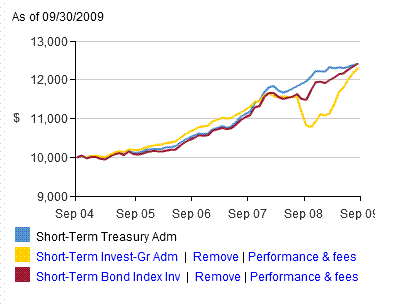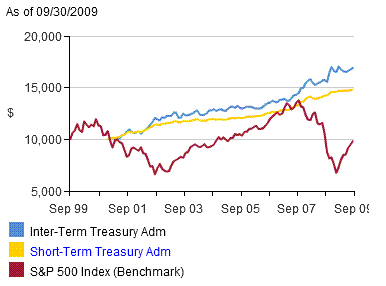free4now
Thinks s/he gets paid by the post
- Joined
- Dec 28, 2005
- Messages
- 1,228
During the recent economic crisis I had most of my bond allocation in short term investment-grade corporate bonds (VFSUX), and learned a tough lesson about credit quality risk, as the value dropped way below treasuries and other "safe" bonds, due to investors getting worried about defaults. See the graph below for a comparison of how much they fell compared with safer bonds.
Now that many timers are fleeing treasuries for junkier bonds, it seems like I'm nearly back on par with treasuries, so it's a good time for me to move into all treasuries (VFIRX), where I should have been all along.
Looking at long term total return performance charts, I tend to wonder what I was thinking chasing the small fraction of a percent yield advantages of corporate bonds over treasuries.
I've seen some folks on this board advocating VBISX, the vanguard short term bond index fund, which is about half treasuries and half corporate bonds. That certainly performed better than VFSUX, but why not just go all the way to full treasuries?
The only thing holding me back from treasuries now is the knowledge that interest rates pretty much can't go any lower, so I'm concerned that when the fed finally gets the balls to start raising interest rates in a year or two the bond NAV will drop. The evil market timer in me says to put everything in money market to avoid that principal loss.
But my understanding is that this treasury interest rate risk of NAV drop shouldn't be very much, as it's only going to fall by approximately the amount of interest rate increase over the duration. Presumably everyone else in the market knows that interest rates will rise, so this is already somewhat priced into the treasury bond fund NAV. So am I crazy for getting into a t-bond fund knowing its NAV is likely to drop in the near future?
I'm generally a buy and holder, intending to hold these for many years, buying or selling only to adjust my asset allocation and take living expense income. I'm just wondering if the current zero percent interest rates are one of those rare market anomalies where timing by investing in MM rather than bonds makes sense.
Now that many timers are fleeing treasuries for junkier bonds, it seems like I'm nearly back on par with treasuries, so it's a good time for me to move into all treasuries (VFIRX), where I should have been all along.
Looking at long term total return performance charts, I tend to wonder what I was thinking chasing the small fraction of a percent yield advantages of corporate bonds over treasuries.
I've seen some folks on this board advocating VBISX, the vanguard short term bond index fund, which is about half treasuries and half corporate bonds. That certainly performed better than VFSUX, but why not just go all the way to full treasuries?
The only thing holding me back from treasuries now is the knowledge that interest rates pretty much can't go any lower, so I'm concerned that when the fed finally gets the balls to start raising interest rates in a year or two the bond NAV will drop. The evil market timer in me says to put everything in money market to avoid that principal loss.
But my understanding is that this treasury interest rate risk of NAV drop shouldn't be very much, as it's only going to fall by approximately the amount of interest rate increase over the duration. Presumably everyone else in the market knows that interest rates will rise, so this is already somewhat priced into the treasury bond fund NAV. So am I crazy for getting into a t-bond fund knowing its NAV is likely to drop in the near future?
I'm generally a buy and holder, intending to hold these for many years, buying or selling only to adjust my asset allocation and take living expense income. I'm just wondering if the current zero percent interest rates are one of those rare market anomalies where timing by investing in MM rather than bonds makes sense.



